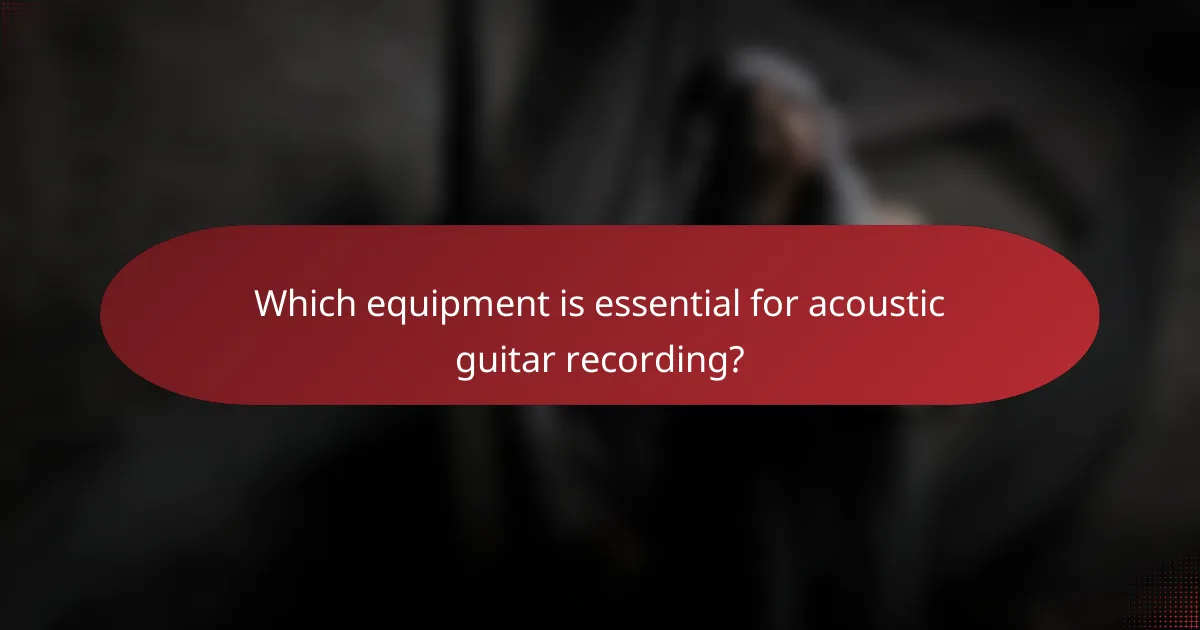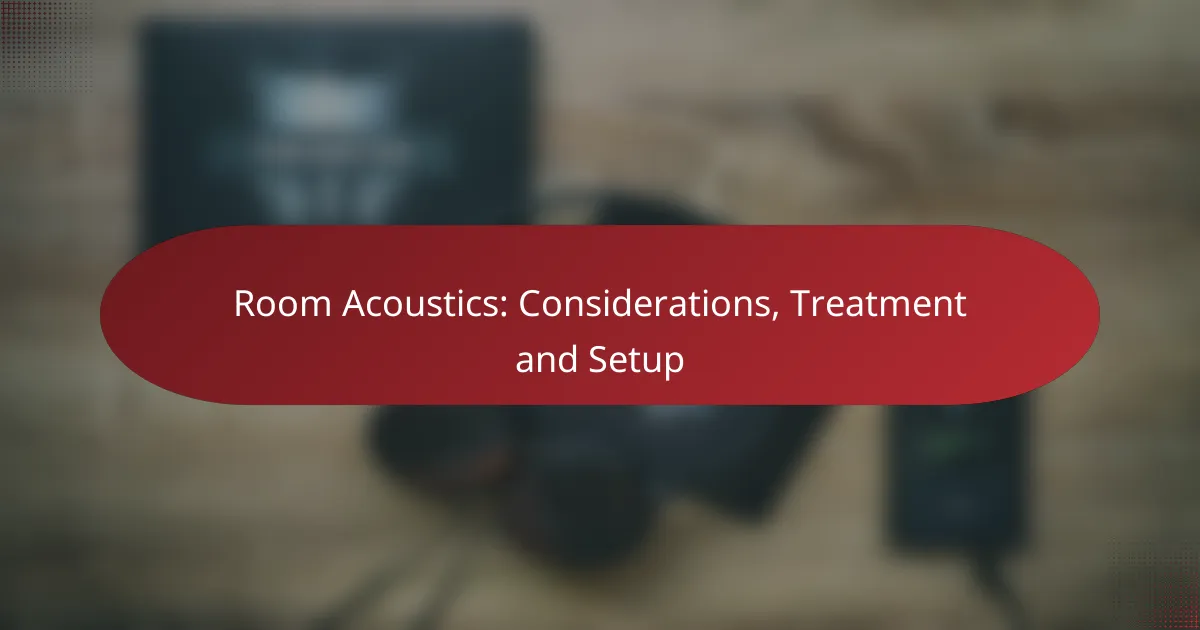Recording acoustic guitar requires a keen understanding of techniques, equipment, and the recording environment to capture its rich, natural sound. Utilizing methods like close-miking and room miking, along with high-quality microphones and audio interfaces, can greatly improve the recording’s clarity and depth. Additionally, an optimized recording space that minimizes noise and controls sound reflections is essential for achieving the best results.

What are the best acoustic guitar recording techniques?
The best acoustic guitar recording techniques focus on capturing the instrument’s natural sound and nuances. Techniques such as close-mic and room mic methods, along with blending and layering tracks, can significantly enhance the overall quality of the recording.
Close-mic technique
The close-mic technique involves placing a microphone very near the acoustic guitar, typically around 6 to 12 inches away. This method captures the detailed sound of the instrument while minimizing background noise. It’s essential to choose the right mic type; condenser mics are often preferred for their sensitivity and clarity.
When using this technique, experiment with mic placement to find the sweet spot, usually around the 12th fret or slightly above the sound hole. Avoid positioning the mic directly in front of the sound hole to prevent excessive bass and muddiness.
Room mic technique
The room mic technique captures the acoustic guitar’s sound in relation to the surrounding environment, providing a more ambient and spacious feel. This method typically involves placing a microphone several feet away from the instrument to pick up reflections and reverberations from the room.
For optimal results, select a room with good acoustics, such as one with soft furnishings to reduce harsh reflections. A stereo pair of microphones can enhance the spatial quality, allowing for a richer sound that blends well with other instruments.
Blending techniques
Blending techniques combine close-mic and room mic recordings to achieve a balanced sound. By layering the two recordings, you can capture the detail from the close mic while adding the warmth and depth from the room mic. This approach creates a fuller, more dynamic sound.
To effectively blend these recordings, adjust the levels and EQ settings to ensure neither mic overshadows the other. A common practice is to keep the close mic slightly louder in the mix while using the room mic to add ambiance.
Using EQ and compression
Using EQ and compression is vital for refining the acoustic guitar’s sound in recordings. EQ allows you to enhance or reduce specific frequencies, helping to eliminate any muddiness or harshness. For example, cutting frequencies around 200-300 Hz can clear up the mix, while boosting around 3-5 kHz can add clarity.
Compression helps control the dynamic range of the guitar, ensuring consistent volume levels throughout the performance. A moderate compression ratio, such as 3:1 or 4:1, can smooth out peaks without squashing the natural dynamics of the instrument.
Layering tracks
Layering tracks involves recording multiple takes of the same guitar part to create a richer sound. This technique can add depth and texture to the recording, making it more engaging. Aim for slight variations in timing and dynamics between layers to create a more organic feel.
When layering, consider panning the tracks slightly left and right in the mix to create a stereo effect. Be cautious not to overcrowd the mix; typically, two to four layers work well without becoming overwhelming.

Which equipment is essential for acoustic guitar recording?
Essential equipment for acoustic guitar recording includes high-quality microphones, audio interfaces, and digital audio workstations (DAWs). These components work together to capture, process, and edit the sound of the guitar effectively.
Microphones for acoustic guitars
Choosing the right microphones is crucial for capturing the nuances of an acoustic guitar. Condenser microphones are often preferred due to their sensitivity and ability to pick up subtle details, while dynamic microphones can be used for a more robust sound. A common setup is to use a combination of both to achieve a balanced recording.
Positioning the microphone is equally important; placing it around 12 inches from the guitar’s sound hole or at the 12th fret can yield excellent results. Experimenting with angles and distances can help find the best sound for your specific guitar and playing style.
Audio interfaces for recording
An audio interface converts the analog signal from your microphone into a digital format for your computer. Look for interfaces with high-quality preamps and low latency to ensure a clear and responsive recording experience. Popular models often feature multiple inputs, allowing for simultaneous recording of multiple instruments or vocals.
When selecting an audio interface, consider connectivity options such as USB or Thunderbolt, as well as compatibility with your operating system. Prices can vary widely, but investing in a reliable interface is essential for achieving professional sound quality.
Digital audio workstations (DAWs)
A digital audio workstation (DAW) is software used for recording, editing, and mixing audio. Popular DAWs for acoustic guitar recording include Ableton Live, Pro Tools, and Logic Pro. Each DAW offers unique features, so choose one that aligns with your workflow and preferences.
Familiarize yourself with the basic functions of your chosen DAW, such as track management, effects processing, and mixing tools. Many DAWs also come with built-in virtual instruments and effects that can enhance your acoustic recordings.
Acoustic guitar pickups
Acoustic guitar pickups are devices that capture the sound of the guitar and convert it into an electrical signal. There are several types, including piezo, magnetic, and microphone-based pickups, each offering different tonal characteristics. Piezo pickups are popular for their clarity and responsiveness, while magnetic pickups provide a warmer sound.
When choosing a pickup, consider how it will affect your overall sound and whether it suits your playing style. Some players prefer to use a combination of pickups and microphones for a richer tone during recordings.
Headphones for monitoring
Quality headphones are essential for monitoring your recordings accurately. Closed-back headphones are ideal for tracking, as they prevent sound leakage and allow you to hear the details of your performance. Look for headphones with a flat frequency response to ensure you are hearing an accurate representation of your sound.
Consider investing in comfortable, durable headphones, as you may be wearing them for extended periods. Brands like Audio-Technica and Sennheiser offer reliable options that are widely used in recording studios.

How to create an ideal recording environment?
Creating an ideal recording environment for acoustic guitar involves controlling sound reflections, minimizing noise, and ensuring proper microphone placement. A well-prepared space enhances sound quality and captures the true essence of the instrument.
Room acoustics treatment
Room acoustics treatment focuses on managing sound reflections and absorption within the recording space. Use materials like acoustic panels, bass traps, and diffusers to minimize unwanted echoes and enhance clarity. Aim for a balanced sound by treating both the walls and ceiling, as this can significantly improve the recording quality.
Consider the size of your room; smaller spaces may require more absorption to prevent muddiness, while larger rooms can benefit from a mix of absorption and diffusion. A good rule of thumb is to cover about 20-30% of the wall surfaces with acoustic treatment for optimal results.
Microphone placement strategies
Microphone placement is crucial for capturing the best sound from an acoustic guitar. Start by positioning the microphone about 12-18 inches from the guitar, aimed at the 12th fret, to achieve a balanced tone. Experiment with angles and distances to find the sweet spot that highlights the instrument’s character.
Using multiple microphones can provide more options during mixing. For instance, combine a close mic with a room mic to capture both detail and ambiance. Just be mindful of phase issues; check for any cancellation by listening through headphones as you adjust placements.
Noise reduction techniques
Implementing noise reduction techniques is essential for maintaining a clean recording. Start by identifying and eliminating sources of noise, such as HVAC systems or outside traffic. Use rugs or carpets to dampen sound reflections and reduce footstep noise in the recording space.
Consider using a high-pass filter on your microphone to cut out low-frequency rumble, and ensure that all electronic equipment is properly grounded to prevent hum. If possible, record during quieter times of the day to minimize background noise interference.
Using isolation booths
Isolation booths can significantly enhance the recording environment by providing a controlled space free from external noise. These booths are designed to minimize sound leakage and can be particularly useful in urban settings where outside noise is prevalent.
When using an isolation booth, ensure that it is adequately treated for acoustics to avoid a boxy sound. If a booth is not available, consider creating a makeshift isolation area using heavy blankets or foam panels to surround the recording space, which can help achieve similar results.

What are the common mistakes in acoustic guitar recording?
Common mistakes in acoustic guitar recording include poor mic placement and ignoring room acoustics. These errors can significantly affect the sound quality and overall recording experience.
Poor mic placement
Poor mic placement can lead to an unbalanced sound, capturing unwanted noise or missing the guitar’s tonal richness. To achieve a better recording, position the microphone about 12 to 18 inches away from the guitar, aiming it at the 12th fret for a balanced tone.
Experiment with different angles and distances to find the sweet spot. For instance, moving the mic closer to the sound hole can emphasize bass frequencies, while positioning it near the neck captures more treble and clarity.
Ignoring room acoustics
Ignoring room acoustics can result in recordings that sound boxy or overly reflective. The environment plays a crucial role in how sound waves interact, so consider the room’s size, shape, and materials when setting up your recording space.
To improve acoustics, use soft furnishings like rugs and curtains to absorb sound, or invest in acoustic panels to minimize echo. A small, treated room often yields better results than a large, untreated space.










